 By Mark Gillies
By Mark Gillies
February 2, 2015
BURLINGTON, ON
Burlington is using the month of August to celebrate local history. Sometime ago the Gazette published a series of articles by Mark Gillies, a lifelong Burlingtonian. It is appropriate to re-publish the stories about the people who built this city.
Would you like to know who I think was one of Burlington’s great business leaders of the early 20th century? Many great people who lived here before us, sacrificed much to help shape Burlington; in order for us to benefit from our beautiful surroundings today. As a local society, we have in far too many cases, turned our backs on these great citizens of Burlington. This is a real shame, and it doesn’t have to be this way.
As in my previous articles, most of the people I write about will be names that you do not recognize, and are now reading for the first time. These outstanding citizens of Burlington accomplished much locally, but have never been properly recognized. One such person is Henry “Harry” Lorimer.
Harry Lorimer moves up the ladder with The Grand Trunk Railway
Harry was born on the family farm in Norfolk County, February 8, 1861. By 1891, Harry left the family business and pursued a career with the Grand Trunk Railway in Norfolk County. Harry’s first job was a telegraph operator, then he became a Railway Agent assigned to a station in Norfolk County, where he perfected his skills, before receiving a promotion that was about to relocate Harry and his family to a more fast paced location, the Burlington Junction Station in Freeman.
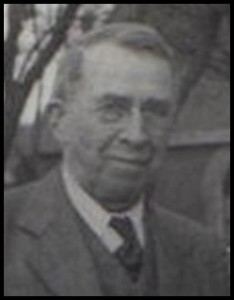
Harry Lorimer was the Burlington Junction Station Master in 1906 when it opened after fire destroyed the previous station in 1904.
By 1897, Harry, his wife Seba, and daughter Gertrude were living in Freeman, and Harry was working as the Grand Trunk Railway Agent. It was very prestigious to be assigned as a Railway Agent to a Junction station. There was so much activity all of the time. Burlington Junction had double track lines running from Montreal right through to Chicago. Trains were travelling both ways. Then, the Grand Trunk Railway had another track running from the Niagara Region, across the Beach, through town, and up to Freeman where it crossed over the double tracks, continuing up to Georgetown, and then up to Allandale.
Burlington Junction also had freight warehouses, which were always busy with boxcars being loaded or unloaded. The responsibility and stress levels were extremely high for Harry Lorimer. The complicated schedules and logistics were unbelievable. Harry was lucky to have a telephone, some needed high tech assistance. The Station Master’s number was easy to remember. Who could forget “2”? Harry was the only Station Master for two different Freeman Stations. One burnt to the ground in 1904, and was replaced by another GTR station in 1906.
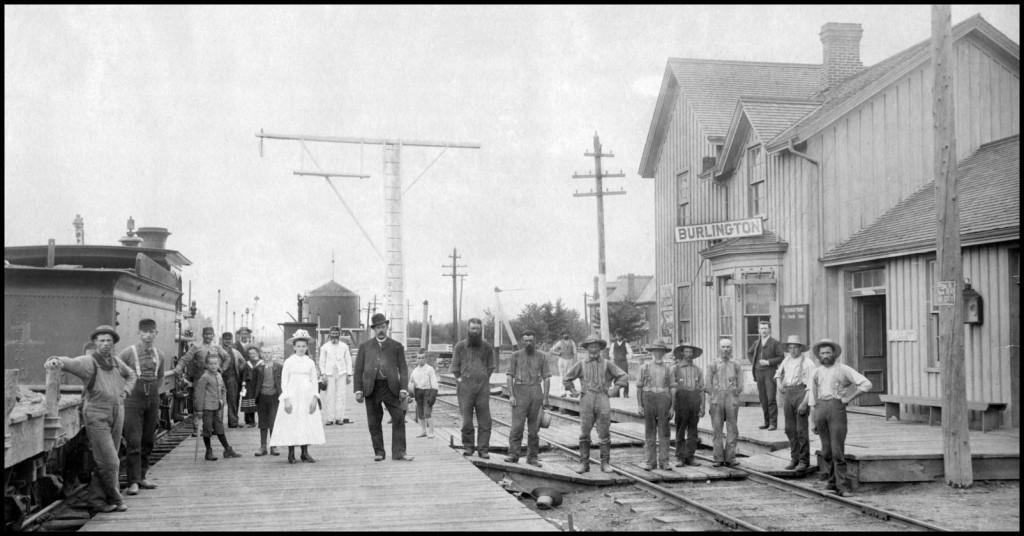
After a fire destroyed the original Great Western Railway train station in 1883, this second station was built by the Grand Trunk Railway, which also succumbed to a fire and was destroyed in 1904. Harry Lorimer was Station Master for both railway stations.

This is the historic 1906 Grand Trunk Railway Station photographed just after it had been built. The GTR identified the station as “Burlington Junction”. Our historic station was one of the busiest Junction stations in all of Canada. Now, thanks to the financial generosity of local citizens and businesses, this 109 year old historic building, owned by the City of Burlington, is in the process of restoration and has been permanently relocated to Fairview Street, west of Brant Street.
The city owned 1906 historic station is now under restoration in a new location on Fairview Street, solely at the expense of private citizens and local businesses, who have come forward to save the station from demolition, as recommended by The City of Burlington. The City of Burlington at one time was to receive close to $1,000,000 in stimulus money to finance the relocation and restoration, but Burlington City Council, several years ago, were unsuccessful in agreement on a new suitable location. Subsequently the City of Burlington lost access to all of this stimulus money. Then, their solution to solve the problem on what to do with this magnificent old building, was a decision to have our heritage rich Freeman Station demolished, despite this being one of Burlington’s most historic buildings, and a huge part of Burlington’s colourful heritage. The citizens of Burlington were outraged at their thinking. Some on City Council still continued to fight to save our beloved Freeman Station and have been officially recognized for their outstanding efforts by the citizen organization, Friends of Freeman Station.
The Station Master was a highly respected citizen
The Station Master or Railway Agent in any town with a railway station was always a very influential and prominent citizen in their community. Railway Agents were very well respected, much like the clergy, police officers, doctors or lawyers. One of the reasons for this high level of respect was due to the fact that new families moving to Canada from Europe, arrived on the scene, and knew no one, often standing on the railway platform, suitcases in hand, and not knowing what to do, or where to go. The first person they saw and who offered to help them was the local Railway Agent. From meeting their first friend in Canada, new arrivals, one day, responded in kind. Often times, throughout Canada, the town’s highly respected Railway Agent also became the local Reeve or Mayor.
In 1901, Harry and his family were well entrenched into Burlington’s local community. Some of their good friends and neighbours were John Thomas Tuck and his family, plus the Ghent family, two very prominent local families. We’re all familiar with John T Tuck School on Spruce Avenue, and we all know where Ghent Avenue is located in Burlington. These two families have been recognized locally, but not so for Harry Lorimer.
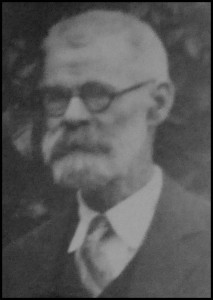
James S. Allen was the proprietor of Allen’s Hardware at the time it was sold to Harry Lorimer and Gordon Colton in 1912. James S. Allen was the nephew of George Allen, the previous owner, who then moved on to build prestigious homes in the core area of Burlington. James S. Allen, later became the Mayor of Burlington from 1925-1928.
Harry Lorimer changes careers and Burlington wins again
In 1912, Harry, who was just 51 years old, made a career change. He became a hardware merchant and bought into an established business with his son-in-law, Gordon Colton. Together, they bought the hardware store, Allen’s Hardware, from James S. Allen, who at one time served as Mayor from 1925-1928. James Allen had previously purchased the business from his uncle George Allen in 1901. George had become Burlington’s most prominent home builder at the time, and was responsible for the building of many of Burlington’s historic homes in the downtown core, which was referred to as the Wellington Park area. The former Allen’s Hardware, was now called Colton & Lorimer Hardware store, and was located at the northeast corner of Brant Street and Pine Street. Their retail neighbour 2 doors north, was Spencer Smith’s green grocery store. I wrote about the remarkable Spencer Smith and his accomplishments in my article on January 12th. The hardware store, from the same location, operated as a thriving business well into the 1970s when it was owned by Keith Dale from Aldershot, and Keith operated it as Dale’s Hardware. Keith Dale purchased the store from the Mills family who had operated it as Mills Hardware, after they purchased it from Harry Lorimer.

The Allen’s Hardware name was removed and the Colton & Lorimer name was added to the outside of the building in 1912. The historic building was located at the northeast corner of Pine & Brant Streets. This historic building met a fate all too familiar in Burlington, and was demolished.
The retailing skills of Harry and Gordon were outstanding, as they both realized Burlington was growing quickly. Harry and Gordon understood that they needed to supply all of the local market gardeners with proper farm supplies, implements, and chemicals, plus they were also aware that new housing starts, and new building construction would provide incremental retail sales. To have everything in stock for both farmers and homeowners, and at the same time was a massive retailing nightmare. Big “Box stores” were not in Burlington yet, close to 100 years into the future, but Harry and Gordon knew exactly what would sell and what to stock in their store. Burlington was their market, and their shrewd retailing skills made Harry and Gordon very successful businessmen.
The Colton & Lorimer Hardware store was extremely successful, undoubtedly the most successful retail location on Brant Street, and most residents in Burlington shopped there. If you were lucky enough to have a telephone in Burlington, you could call Colton & Lorimer. Their number was “9”. If Colton & Lorimer didn’t have what you wanted, then you really didn’t need it. Colton & Lorimer had fine-tuned hardware retailing to a science.
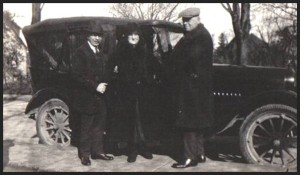
Harry Lorimer proved to be a superior retailer, and as a result the Lorimer’s attained substantial affluence. Along with the purchase of a custom made house, built by Burlington’s most prominent builder, George Allen; Harry & Seba also acquired a luxurious automobile and were driven about town by Bob, their chauffeur.
With hard work, comes the spoils, Burlington’s on a roll
Harry and Seba finally decided to purchase a new home. They also decided to buy an automobile, and hire a chauffeur to drive them around. The hardware business was doing that well. The beautiful home they chose was built by Burlington’s most prominent home builder George Allen. Many of George Allen’s beautiful homes have now been designated as historical. The Lorimer residence was built in 1914 on a lot to the north of George Allen’s own historic house at 1391 Ontario Street. George Allen did not disappoint the Lorimer family. Their new home was stunning. The historic Lorimer family is at 504 Burlington Avenue, and the house just had its 100th birthday.

George Allen built this beautiful home for the Lorimer family, and they moved here in 1914. The house at one time was recognized as historical, but in 2013 it was removed from the Registry by the City of Burlington for alleged lack of historical significance.
City of Burlington insults Harry Lorimer’s legacy 50 years later
This beautiful home was lived in by the prominent Lorimer family for 50 years, from 1914 until 1964, and at one time was recognized as historical and added to the Municipal Register of Cultural Heritage Resources, then was officially removed from the Register in 2013 for what was said the be a lack of historical, architectural, or contextual value. (I know what you’re thinking, I’m not making this up, it really happened). The City of Burlington defends its heritage reasoning found on their website as follows:
What is Heritage Conservation?
“Heritage conservation involves identifying, protecting and promoting the elements that our society values. Heritage conservation has traditionally been associated with protecting the physical or built environment (buildings, structures, landscapes, facts etc.). More recently, the term has also come to be associated with safeguarding the non-physical associations between people and a place (associations linked to use, meanings and cultural or spiritual values).”Taken from Parks Canada Standards and Guidelines for the Conservation of Historic Places in Canada
Why is Conservation Planning Important?
The conservation of built heritage is an integral part of the land use planning process at the City of Burlington. It entails planning for the identification, protection and promotion of the heritage resources that our community values. Burlington’s heritage is a living legacy that helps us understand our past, provides us context for the present and influences our future.
Why Conserve our Heritage?
The conservation of cultural and heritage properties is vital to a community’s overall cultural and economic development and it can enrich our lives, inspire us and create a sense of community that can sustain generations. The Heritage planning process in Burlington is overseen by staff in consultation with the Heritage Burlington Committee.
The Passing of Harry Lorimer and his Family
Harry lived to be 99 years old, and passed away peacefully in 1960. His beloved wife Seba died 10 years earlier at 85 years of age in 1950. Gertrude, their daughter died at 76 years of age in 1964, and her husband Gordon tragically died at 31 years of age in 1918 as a result of the great influenza epidemic. They are all buried together as family, in Aldershot’s historic Greenwood Cemetery. All residents of Burlington owe a huge debt of gratitude to the Lorimer and Colton families. These two dynamic families were true genuine pillars of the community and did far more than their fair share in helping to build, shape and drive Burlington’s economic engine so efficiently into the 20th century
Plan to Attend Heritage Days
On Saturday, February 7th at Burlington Central Library, Heritage Days will be in full swing with many wonderful displays of Burlington’s local heritage featured for the public to view. Plan to take the children or grandchildren. It’s free to everyone. There will also be several guest speakers throughout the event. Heritage Days will be from 10:00 AM to 3:30 PM. One display you will not want to miss, will be the Burlington Junction Train Station 1:24 scale model. This beautiful model was handcrafted by Burlington resident, Mr. Bob Chambers. Thanks to Bob’s talents, you will get to see what life was like in 1906 when the historic train station opened, and Harry Lorimer was its first Station Master.
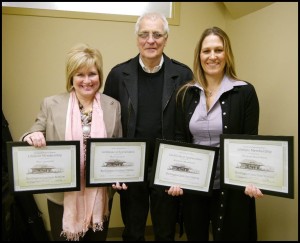
Councillors Marianne Meed Ward and Blair Lancaster, both heritage preservation advocates were recognized by the citizen group “Friends of Freeman Station” for their perseverance and leadership in convincing the others on City Council that the Freeman Station was worth saving.
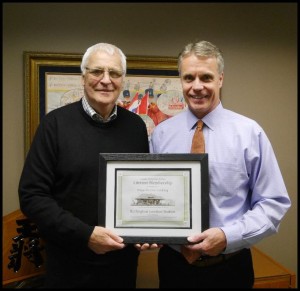
Mayor Rick Goldring was recognized by “Friends of Freeman Station” for his personal involvement in helping to save the Freeman Station from demolition, as recommended by the City of Burlington. Mayor Goldring received a Lifetime Membership to Friends of Freeman Station from Brian Aasgaard, President of Friends of Freeman Station.
The Friends of Freeman Station will be there to answer all of your questions. Please plan to donate generously to help these exceptional volunteers complete the restoration of this magnificent historical building, something the City of Burlington could not accomplish. Without private financial support, this Burlington Junction restoration cannot be completed. There is no local, provincial, or federal government funding.
My next article on February 9th will be on the Burlington Junction Station, or as it is so often called, the Freeman Station. Find out why I believe Burlington Junction Station is Burlington’s most historical building, and why we need to make sure this part of our local heritage is preserved for future generations.
Related article:



















Good article its nice to see Brian Aasgaard getting a little glory on this restoration. He and John Mellow have kept this project alive when many wanted to throw in the towel. The help of Councillors Lancaster and Meed Ward to get it moving out of the quagmire in City Hall certainly helped.
We should also thank many people within the construction industry who came to help,many of whom never show their faces but are always there to help.
There was a realization when we realized that very likely our ancestors travelled from Freeman Station to reach Lowville from Ireland.